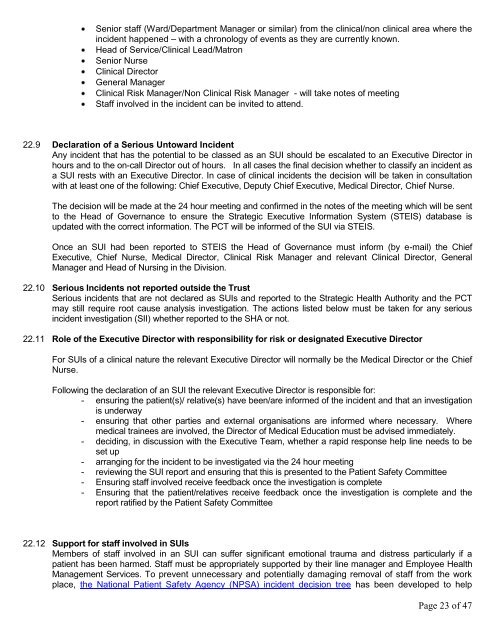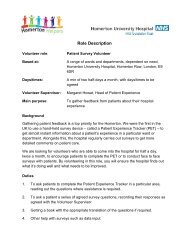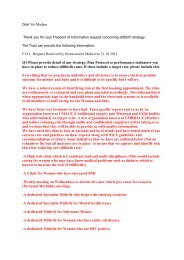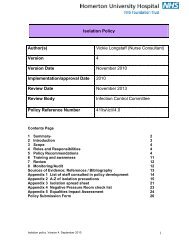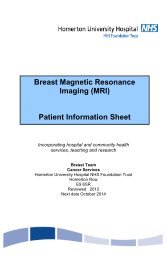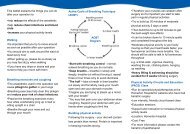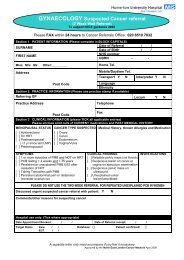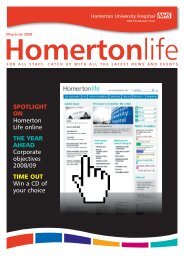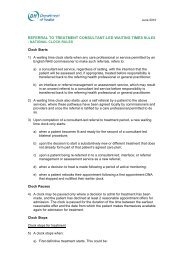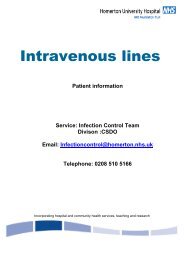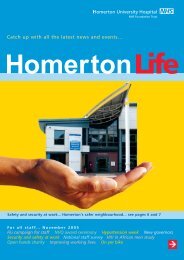Incident reporting policy - Homerton University Hospital
Incident reporting policy - Homerton University Hospital
Incident reporting policy - Homerton University Hospital
Create successful ePaper yourself
Turn your PDF publications into a flip-book with our unique Google optimized e-Paper software.
Senior staff (Ward/Department Manager or similar) from the clinical/non clinical area where theincident happened – with a chronology of events as they are currently known.Head of Service/Clinical Lead/MatronSenior NurseClinical DirectorGeneral ManagerClinical Risk Manager/Non Clinical Risk Manager - will take notes of meetingStaff involved in the incident can be invited to attend.22.9 Declaration of a Serious Untoward <strong>Incident</strong>Any incident that has the potential to be classed as an SUI should be escalated to an Executive Director inhours and to the on-call Director out of hours. In all cases the final decision whether to classify an incident asa SUI rests with an Executive Director. In case of clinical incidents the decision will be taken in consultationwith at least one of the following: Chief Executive, Deputy Chief Executive, Medical Director, Chief Nurse.The decision will be made at the 24 hour meeting and confirmed in the notes of the meeting which will be sentto the Head of Governance to ensure the Strategic Executive Information System (STEIS) database isupdated with the correct information. The PCT will be informed of the SUI via STEIS.Once an SUI had been reported to STEIS the Head of Governance must inform (by e-mail) the ChiefExecutive, Chief Nurse, Medical Director, Clinical Risk Manager and relevant Clinical Director, GeneralManager and Head of Nursing in the Division.22.10 Serious <strong>Incident</strong>s not reported outside the TrustSerious incidents that are not declared as SUIs and reported to the Strategic Health Authority and the PCTmay still require root cause analysis investigation. The actions listed below must be taken for any seriousincident investigation (SII) whether reported to the SHA or not.22.11 Role of the Executive Director with responsibility for risk or designated Executive DirectorFor SUIs of a clinical nature the relevant Executive Director will normally be the Medical Director or the ChiefNurse.Following the declaration of an SUI the relevant Executive Director is responsible for:- ensuring the patient(s)/ relative(s) have been/are informed of the incident and that an investigationis underway- ensuring that other parties and external organisations are informed where necessary. Wheremedical trainees are involved, the Director of Medical Education must be advised immediately.- deciding, in discussion with the Executive Team, whether a rapid response help line needs to beset up- arranging for the incident to be investigated via the 24 hour meeting- reviewing the SUI report and ensuring that this is presented to the Patient Safety Committee- Ensuring staff involved receive feedback once the investigation is complete- Ensuring that the patient/relatives receive feedback once the investigation is complete and thereport ratified by the Patient Safety Committee22.12 Support for staff involved in SUIsMembers of staff involved in an SUI can suffer significant emotional trauma and distress particularly if apatient has been harmed. Staff must be appropriately supported by their line manager and Employee HealthManagement Services. To prevent unnecessary and potentially damaging removal of staff from the workplace, the National Patient Safety Agency (NPSA) incident decision tree has been developed to helpPage 23 of 47


